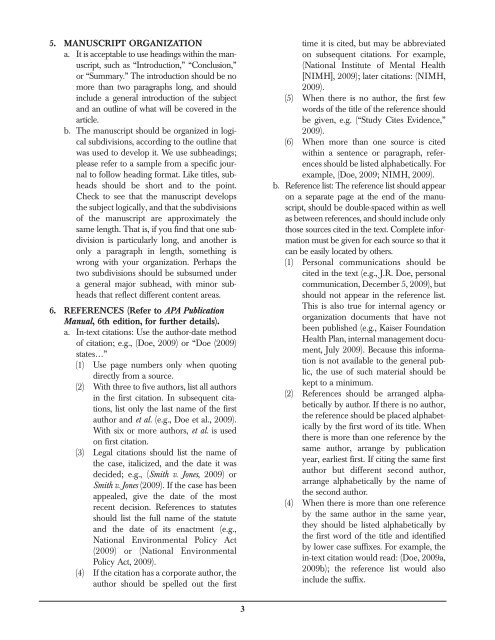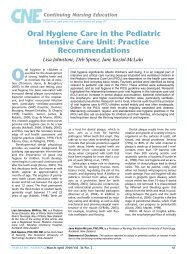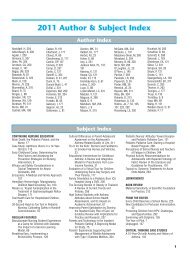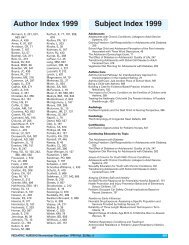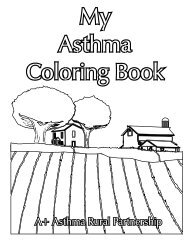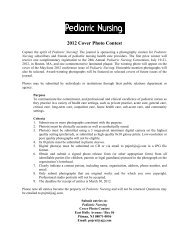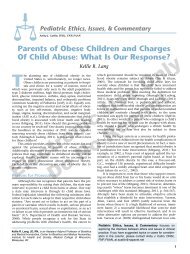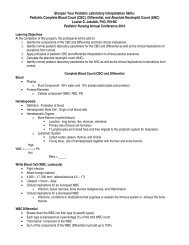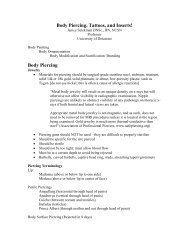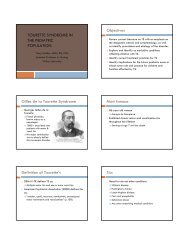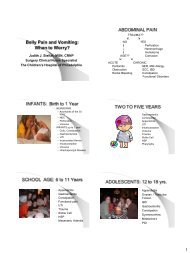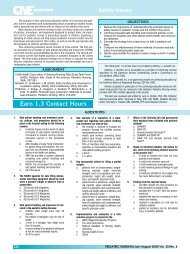Jannetti Publications Guidelines For Authors - Pediatric Nursing
Jannetti Publications Guidelines For Authors - Pediatric Nursing
Jannetti Publications Guidelines For Authors - Pediatric Nursing
Create successful ePaper yourself
Turn your PDF publications into a flip-book with our unique Google optimized e-Paper software.
5. MANUSCRIPT ORGANIZATION<br />
a. It is acceptable to use headings within the manuscript,<br />
such as “Introduction,” “Conclusion,”<br />
or “Summary.” The introduction should be no<br />
more than two paragraphs long, and should<br />
include a general introduction of the subject<br />
and an outline of what will be covered in the<br />
article.<br />
b. The manuscript should be organized in logical<br />
subdivisions, according to the outline that<br />
was used to develop it. We use subheadings;<br />
please refer to a sample from a specific journal<br />
to follow heading format. Like titles, subheads<br />
should be short and to the point.<br />
Check to see that the manuscript develops<br />
the subject logically, and that the subdivisions<br />
of the manuscript are approximately the<br />
same length. That is, if you find that one subdivision<br />
is particularly long, and another is<br />
only a paragraph in length, something is<br />
wrong with your organization. Perhaps the<br />
two subdivisions should be subsumed under<br />
a general major subhead, with minor subheads<br />
that reflect different content areas.<br />
6. REFERENCES (Refer to APA Publication<br />
Manual, 6th edition, for further details).<br />
a. In-text citations: Use the author-date method<br />
of citation; e.g., (Doe, 2009) or “Doe (2009)<br />
states…”<br />
(1) Use page numbers only when quoting<br />
directly from a source.<br />
(2) With three to five authors, list all authors<br />
in the first citation. In subsequent citations,<br />
list only the last name of the first<br />
author and et al. (e.g., Doe et al., 2009).<br />
With six or more authors, et al. is used<br />
on first citation.<br />
(3) Legal citations should list the name of<br />
the case, italicized, and the date it was<br />
decided; e.g., (Smith v. Jones, 2009) or<br />
Smith v. Jones (2009). If the case has been<br />
appealed, give the date of the most<br />
recent decision. References to statutes<br />
should list the full name of the statute<br />
and the date of its enactment (e.g.,<br />
National Environmental Policy Act<br />
(2009) or (National Environmental<br />
Policy Act, 2009).<br />
(4) If the citation has a corporate author, the<br />
author should be spelled out the first<br />
time it is cited, but may be abbreviated<br />
on subsequent citations. <strong>For</strong> example,<br />
(National Institute of Mental Health<br />
[NIMH], 2009); later citations: (NIMH,<br />
2009).<br />
(5) When there is no author, the first few<br />
words of the title of the reference should<br />
be given, e.g. (“Study Cites Evidence,”<br />
2009).<br />
(6) When more than one source is cited<br />
within a sentence or paragraph, references<br />
should be listed alphabetically. <strong>For</strong><br />
example, (Doe, 2009; NIMH, 2009).<br />
b. Reference list: The reference list should appear<br />
on a separate page at the end of the manuscript,<br />
should be double-spaced within as well<br />
as between references, and should include only<br />
those sources cited in the text. Complete information<br />
must be given for each source so that it<br />
can be easily located by others.<br />
(1) Personal communications should be<br />
cited in the text (e.g., J.R. Doe, personal<br />
communication, December 5, 2009), but<br />
should not appear in the reference list.<br />
This is also true for internal agency or<br />
organization documents that have not<br />
been published (e.g., Kaiser Foundation<br />
Health Plan, internal management document,<br />
July 2009). Because this information<br />
is not available to the general public,<br />
the use of such material should be<br />
kept to a minimum.<br />
(2) References should be arranged alphabetically<br />
by author. If there is no author,<br />
the reference should be placed alphabetically<br />
by the first word of its title. When<br />
there is more than one reference by the<br />
same author, arrange by publication<br />
year, earliest first. If citing the same first<br />
author but different second author,<br />
arrange alphabetically by the name of<br />
the second author.<br />
(4) When there is more than one reference<br />
by the same author in the same year,<br />
they should be listed alphabetically by<br />
the first word of the title and identified<br />
by lower case suffixes. <strong>For</strong> example, the<br />
in-text citation would read: (Doe, 2009a,<br />
2009b); the reference list would also<br />
include the suffix.<br />
3


